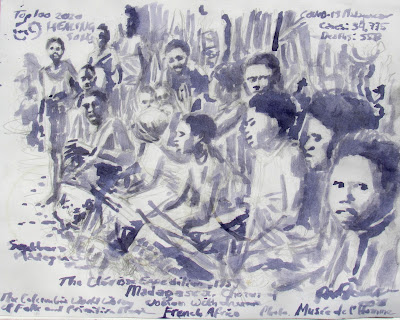The next ones up for both the Top 100s of 2020 and 2021 are recordings from the Clerisse Expidition to Madagascar of 1939. The provisional number 8 of this year and number 69 from 2020 are songs number 20 and 21 from the French Africa volume of the Columbia World Library of Folk and Primitive Music. Number 23, and fourth from the Clerisse Expedition, from that record I illustrated earlier (#33, Top 100 2020). This was in October 2020. When I wrote about the painting back in October, I regretted that I did not use a photograph from the Clerisse Expedition but settled for an exotic vintage photograph as for a source. The regret is now only enhanced as I could not find any photographs from the Clerisse Expedition anymore beyond this one image reproduced in the liner notes. I wonder where the heck I saw these back in October. For both of the current paintings I used this one photo from the Columbia Library labelled: "Madagascar, chorus of women with drums." The photo in the liner notes is not a direct illustration of any of the recordings from the expedition on the record because the instrumentation doesn't match, but may very well have been taken at the same place, at the same date, and with perhaps some of the same people as some of the songs. The songs in the Top 100 are: Healing Song from Southern Madagascar, and Song of Exorcism for which the Sakalave tribe is listed as performers. The Sakalave, as a tribe, have genetically more in common with east Asian people than with continental Africans, which makes it unlikely the photograph depicts that tribe. The Sakalava (as it should be spelled) are an ethnic group in Madagascar rather than a tribe. Madagascar is quite modern these days and rather homogeneous, speaking one language: Malagasy. When the recordings were made in in 1939, and the Columbia record released in 1954, Madagascar was part of French Africa. The expedition, and the musical recordings, are rooted in colonialism, with the greatest separation between the recorder and those recorded thus far in these series of paintings that addresses this topic. The separation was made even deeper because no individual musicologist or anthropologist is listed for these recordings. The photograph is not credited either. As I mentioned I was not able to find photographs from the expedition, and I could not find an image depicting Henri Clerisse, the leader of the expedition, either. All I could find were a few names that were part of the expedition. I settled for a photo of the botanist, and colonial administrator Raymond Decary, to represent the colonial context of the recording of the Sakalava in the Top 100 2021. The photograph, reproduced on two different websites, shows the photo sideways, as if he were standing up. Very strange. Directly after I finished the painting in oils representing the recording of the Sakalava people, I started on the one from Southern Madagascar using the very same image, but now with ink on paper. I sketched every individual who appeared in the photo. (I only used the three closest to the photographer earlier.) The Healing Song consists of a female chorus followed by a male chorus. The rhythm is provided by hand clapping and gun shots are heard (to ward off evil spirits, according to Andre Schaeffner, who wrote the lines on the album.) The Sakalava song, Song of Exorcism, also consisted of both male and female choruses, soloists, and again, hand clapping.


No comments:
Post a Comment